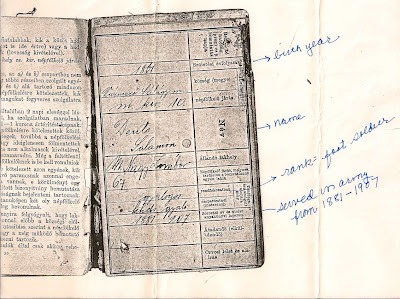I wondered with the help of Google's Translator if I could verify the original translations, and perhaps learn a bit more about the documents. Computer translations are notorious for hacking up languages, but I figured it should get me at least close. And I was correct.
Here's the front and back of the booklet (click on any image to enlarge):

As you can see, none of it is translated - there's only the identification of the crest.
Google Translator had no idea what Nepfolkelesi meant. It told me that Nepfolkelesi igazolvanyi konyv means Nepfolkelesi paper card. So I knew it meant an identification card of some sort. I conducted a Google web search and there found someone with the exact document I had seeking a translation. It means 'popular uprising'. When I put those words into the translator, it returns the Hungarian words: Népszerű felkelés. So it appears that Nepfolkelesi is a 'portmanteau' - a blend of two or more words. The translation given on the website said "Popular Uprising identification card." which is what I figured. And we were off.
I recognized my great grandfather's name, Salamon Deuts. He went by both Salamon and Samuel, and the surname was originally Deuts. The following line says he was a foot soldier (gyalogos) in the 57th regiment.
The next line says "Year of Birth" - 1861. It would have been nice if any of the documents got more specific, but they don't. Still, it provides a good source for the year.
The table at the bottom was difficult to interpret because I think the individual who filled out the form filled it out incorrectly. The top rows should be his years as a recruit (hadkiegeszito). Instead, it was filled out as 1/1 (January 1) 1895. Starting in 1896 and ending (beszarolag) in 1903 he was in the service.
I'd love to know what all the calculations on the back of the booklet mean.

Here's an inside page with some translation notes. 1881-1907 is now given as his years of service. Some internet research indicates age 19 or 20 was a common age to enter the army. From 1881-1895 he must have been in training, in reserves, or some other non-active category. Similarly from 1904-1907.
At the top of the form, 'kozseg' means 'village'. Szilagy is a Hungarian county in Transylvania. I believe the town is Varmezo (or Buciumi, Romania)
 This page further clarifies his years of service. Signed on December 31, 1894, it seems to say he would be a Foot Soldier First Class until December 31, 1898, and Second Class until 1903. The information on the right hand side is repetitive from other pages.
This page further clarifies his years of service. Signed on December 31, 1894, it seems to say he would be a Foot Soldier First Class until December 31, 1898, and Second Class until 1903. The information on the right hand side is repetitive from other pages.There are still a lot of words untranslated, but I have been able to build upon the translation notes that had previously been made, and I have a better understanding of my great grandfather's military service.
He married my great grandmother in 1898 (according to an audiotape my grandfather made in the 1970s) and my grandfather also believed he had a prior wife, and children who remained in Hungary. My grandfather was born in 1907, but several older siblings were born during the period 1899-1903, so his service as a foot soldier included some family leave time, at least in the post-1898 period.








No comments:
Post a Comment